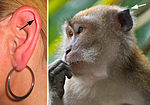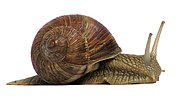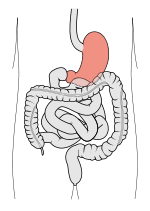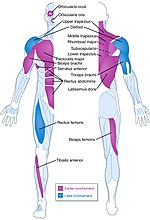Muscular evolution in humans is an overview of the muscular adaptations made by humans from their early ancestors to the modern man. Humans are believed... 12 KB (1,686 words) - 22:39, 9 March 2024 |
thus human biology was created. The key aspects of human biology are those ways in which humans are substantially different from other mammals. Humans have... 10 KB (1,260 words) - 21:16, 21 April 2024 |
 | Sex differences in human physiology are distinctions of physiological characteristics associated with either male or female humans. These differences are... 85 KB (9,591 words) - 15:00, 2 May 2024 |
 | In the context of human evolution, human vestigiality involves those traits occurring in humans that have lost all or most of their original function... 51 KB (6,391 words) - 01:43, 8 May 2024 |
 | Skeletal muscle (redirect from Muscular branches) vertebrate muscular system and typically are attached by tendons to bones of a skeleton. The muscle cells of skeletal muscles are much longer than in the other... 120 KB (13,876 words) - 14:33, 17 April 2024 |
 | "Ejaculate quality, testes size and sperm competition in primates". Journal of Human Evolution. 17 (5): 479–488. doi:10.1016/0047-2484(88)90037-1. Mautz... 71 KB (8,280 words) - 20:25, 7 May 2024 |
are used in the context of human evolution, to distinguish: "robust" vs. "gracile" australopithecines, see Paranthropus "robust" archaic humans vs. "gracile"... 2 KB (160 words) - 22:08, 8 January 2024 |
Origin of language (redirect from Evolution of language in humans) compared to anything found among non-humans, must have appeared fairly suddenly during the course of human evolution. Some theories consider language mostly... 175 KB (21,463 words) - 20:05, 17 April 2024 |
 | Shoulder girdle (section In humans) attachment being muscular. The shoulder girdle is the anatomical mechanism that allows for all upper arm and shoulder movement in humans. The shoulder girdle... 15 KB (1,814 words) - 19:49, 29 June 2023 |
very little muscular tissue, and this exists in its root. The shaft and glans have no muscle fibers. Unlike most other primates, male humans lack a penile... 149 KB (15,930 words) - 16:39, 1 April 2024 |
 | Palmaris longus muscle (section Evolution) of the muscle's absence is that humans inherited the muscle through common descent, and numerous animals that humans share a common ancestor with (such... 11 KB (1,260 words) - 18:07, 4 May 2024 |
 | Snake (redirect from Snake evolution) in this manner. Snakes do not ordinarily prey on humans. Unless startled or injured, most snakes prefer to avoid contact and will not attack humans.... 149 KB (15,049 words) - 10:18, 6 May 2024 |
 | Mollusca (section Uses by humans) whole upper surface. The underside of the animal consists of a single muscular "foot". Although molluscs are coelomates, the coelom tends to be small... 93 KB (9,438 words) - 10:13, 14 April 2024 |
 | Myostatin (redirect from Bovine muscular hypertrophy) therapeutic application in treating muscle wasting diseases such as muscular dystrophy. The gene encoding myostatin was discovered in 1997 by geneticists... 48 KB (5,322 words) - 10:36, 6 April 2024 |
flying–all the different ways of defying gravity–in imagination and in technology, in humans and in animals. It ranges over many instances of flight including... 3 KB (212 words) - 09:18, 18 May 2023 |
 | Organ (biology) (section Origin and evolution) intestines, gallbladder, bladder, and rectum. In the thoracic cavity, the heart is a hollow, muscular organ. Splanchnology is the study of the viscera... 21 KB (2,018 words) - 05:55, 9 May 2024 |
 | Origin of speech (redirect from Evolution of speech) for phonation. In humans, the larynx is descended, it is positioned lower than in other primates. This is because the evolution of humans to an upright... 64 KB (7,995 words) - 20:02, 29 April 2024 |
 | Alligator (redirect from Evolution of alligators) underwater and to provide calcium for eggshell formation. Alligators have muscular, flat tails that propel them while swimming. The two kinds of white alligators... 45 KB (4,921 words) - 21:44, 17 April 2024 |
 | Gluteus maximus (section In art) characteristic features of the muscular system in humans, connected as it is with the power of maintaining the trunk in the erect posture. Other primates... 13 KB (1,423 words) - 10:29, 6 February 2024 |
 | The human genome is a complete set of nucleic acid sequences for humans, encoded as DNA within the 23 chromosome pairs in cell nuclei and in a small DNA... 99 KB (10,151 words) - 19:49, 15 April 2024 |
 | Felidae (redirect from Evolution of felids) patterns of all terrestrial carnivores. Cats have retractile claws, slender muscular bodies and strong flexible forelimbs. Their teeth and facial muscles allow... 49 KB (3,880 words) - 10:22, 22 April 2024 |
 | Stomach (redirect from Anatomy of the human stomach) The stomach is a muscular, hollow organ in the upper gastrointestinal tract of humans and many other animals, including several invertebrates. The stomach... 47 KB (5,039 words) - 11:31, 6 May 2024 |
 | Cro-Magnon (redirect from Early European humans) Cro-Magnons or European early modern humans (EEMH) were the first early modern humans (Homo sapiens) to settle in Europe, migrating from western Asia,... 150 KB (18,823 words) - 04:43, 8 April 2024 |
 | Gallbladder (category All Wikipedia articles written in American English) stored and concentrated before it is released into the small intestine. In humans, the pear-shaped gallbladder lies beneath the liver, although the structure... 34 KB (3,969 words) - 11:02, 5 February 2024 |






